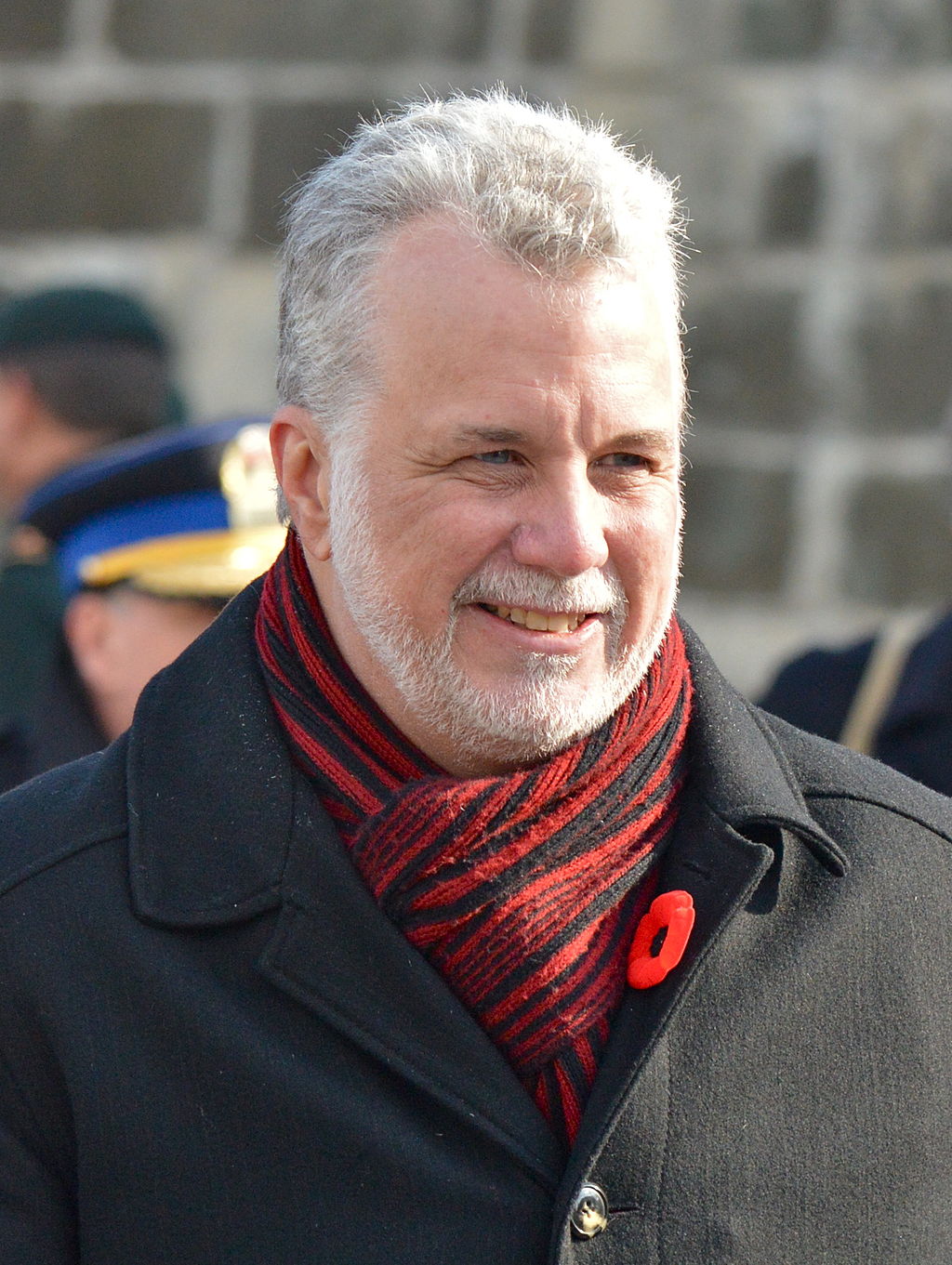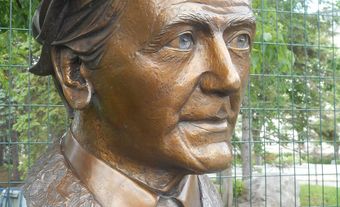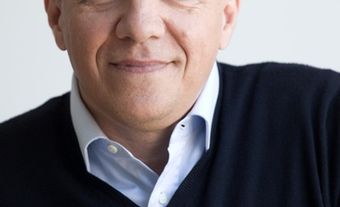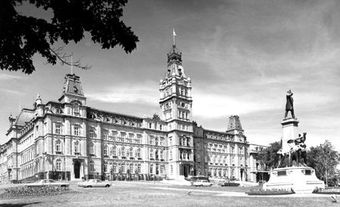The Liberal Party is both the oldest political party in Quebec and the party that has been in power most often in the province’s history. The party was at the forefront of the Quiet Revolution in the early 1960s. It supports federalism and promotes economic development in the province. The current interim party leader is Marc Tanguay.

Founding of the Quebec Liberal Party
The party that became the Quebec Liberal Party (QLP) at the end of the 19th century had its beginnings in the early 1870s. During the provincial elections of 1886 and 1890, the Liberals joined forces with the Parti national, and then the QLP itself formed the government after the 1897 election. Benefiting from the success of Wilfrid Laurier federally, the QLP governed in Quebec until the middle of the 1930s. During this period, it won some resounding electoral victories against the conservatives. The party consisted of well-known public figures who favoured a conventional liberal program based on economic development. The QLP was a centrist and federalist party that represented the interests of the business community.
At the beginning of the 1930s, Louis-Alexandre Taschereau was the leader of the QLP. The combined effects of the Great Depression and corruption in the party had slowly eroded the political capital of the QLP and, as a result, the party entered a period of decline. Diminished after the 1935 election, the Liberal government gave way to Maurice Duplessis’ Union nationale in the 1936 election. However, the QLP returned to power under Adélard Godbout in 1939. Although the QLP’s political adversaries accused it of being too close to the government in Ottawa, the party carried out some ground-breaking initiatives under Godbout’s leadership, including giving women the right to vote in 1940 and creating Hydro-Québec in 1944. Defeated in the 1944 election, the Liberals began a 15-year period in opposition.

Renewal of the Quebec Liberal Party in the 1960s
Under the leadership of George-Émile Lapalme, the QLP reinvented itself in the late 1950s as a party representing the interests of the people. Lapalme was replaced as party leader by Jean Lesage, who, along with his so-called “équipe du tonnerre” (“dream team”), led a vigorous campaign against the Union nationale’s Antonio Barrette in the 1960 election. Benefiting from voter interest in the election, the QLP returned to power with 51 seats in the National Assembly and 51.5 per cent of the vote. The Liberals championed an innovative program that would leave its mark on Quebec’s subsequent political evolution. Under the slogan “Maîtres chez nous” (“Masters of our own house”), the government launched a process of political modernization that embraced social and economic change in Quebec society. This period in Quebec’s history is known as the Quiet Revolution. During two terms in office (1960–62 and 1962–66), the Liberals significantly updated the structure of the government and the public service in Quebec. The party left its mark particularly by nationalizing the province’s electric companies in 1962, a venture that came to symbolize the period’s political transformation. Under the leadership of the QLP, the Quebec state adopted a more interventionist approach, even though Lesage himself claimed to have a rather conservative disposition. In 1966, the Liberals were ousted from power following what has been described as a “phony” victory by the Union nationale, which received less of the popular vote (40 per cent) than the Liberals (47 per cent), but which benefited from greater support in the regions.

Constitutional Positioning: 1970s to 1990s
Under the leadership of the young Robert Bourassa, the QLP won 72 seats in the 1970 election and regained power. Bourassa, who had a reputation for taking somewhat vague positions on constitutional matters, promoted Quebec’s economy and its autonomy. In the 1970s, the Liberals were known especially for the emphasis they placed on major economic projects and for their promise to create 100,000 jobs through the construction of public buildings, the massive James Bay hydroelectric dam, and other large-scale infrastructure such as highways. The Liberal government also implemented significant social measures by, for example, establishing a health insurance program (see Health Policy). Despite having been faced with the October Crisis in 1970, the QLP won a convincing victory at the 1973 election, taking 102 of 110 seats in the National Assembly. However, the Bourassa Liberals’ second term was difficult, as the party lost the support of its traditional allies — including the anglophone community and part of the business community — and ultimately suffered defeat at the hands of the Parti Québécois (PQ) in 1976. The Liberals found themselves in opposition with a new leader, Claude Ryan, who led the party through the 1980 referendum and the 1981 election. Ryan never managed to revitalize the QLP, and the party did not return to power until 1985, when it won 99 seats and took 55 per cent of the vote with Bourassa once again at the helm.
Political Programs and Constitutional Position
The Liberal governments of the 1970s were not right-wing, but the party’s orientation changed during its following two terms in office (1985–89 and 1989–94). Principally, the QLP proceeded to clean up the government’s finances (see Public Finance). It created a team of agents, sarcastically called “boubou-macoutes,” who were responsible for confirming that recipients of welfare benefits complied with the rules for receiving aid. (“Boubou-macoutes” was a spin on the term “tonton macoutes,” the name given to the brutal paramilitary force created by Haitian president, François Duvalier. “Boubou” was a nickname for Robert Bourassa.) The Liberals also proposed a review of government operations. It was a turbulent period for the party. The Liberals faced a significant backlash on language matters, particularly with respect to bilingual signage (see Bill 86), and they also had to manage the Oka crisis, which pitted the government against the Mohawk people in the summer of 1990.
During this period, the QLP was a principal player in the 1987 constitutional negotiations that led to the Meech Lake Accord. The party’s constitutional position was reflected in the accord’s five conditions, particularly the clause that recognized Quebec as a distinct society. Following the 1990 failure of the Accord, the QLP adopted a nationalist orientation. On 22 June 1990, Bourassa stated that Quebec was “a distinct society, free and capable of assuming its destiny and its development.” The party ultimately returned to its federalist position, but some Liberals left the QLP to form the Action démocratique du Québec (ADQ). The party unsuccessfully defended the Charlottetown Accord during the 1992 referendum, and it was then defeated in the 1994 election with Bourassa’s successor, Daniel Johnson, at the helm.

Turbulent Years: 1990s to 2010s
In 1998, the leader of the Progressive Conservative Party, Jean Charest, made the jump to provincial politics and became leader of the provincial Liberals. Given the strong role Charest played for the “No” side in the 1995 referendum, he was seen as the best candidate to challenge Lucien Bouchard, the leader of the sovereigntists. However, the QLP soon found itself facing an election campaign. Unprepared, Charest fared poorly against the PQ leader. Despite receiving a slightly higher percentage of the vote than the PQ (43 per cent to 42 per cent), the Liberals took only 48 seats, compared with 76 for the PQ.
With a battle-hardened Charest, the QLP won the 2003 election and took 76 seats with 46 per cent of the vote. The party proposed reforms intended to “re-engineer” the state, while at the same time focusing on healthcare. However, this drive for reform soon provoked a backlash, and the Liberal government was forced to make an about-face on a number of fronts. When the March 2007 election dawned, the party was weakened and consumed by the so-called “crisis” over reasonable accommodation, and support for the ADQ rose as a result. The QLP came out of the election in a minority position — 48 seats, compared with 41 for the ADQ and 36 for the PQ. In 2008, the party was handed a majority, winning 66 seats in the National Assembly, but it remained the second-choice party for francophone voters.
Between 2008 and 2012, the QLP focused on promoting the development of the province’s natural resources, particularly in the mining sector, with an ambitious project called the Plan Nord (Northern Plan). Once again, the party presented itself as a champion of economic growth. However, the announcement of an increase in provincial postsecondary tuition fees provoked major demonstrations by student associations, called the “Maple Spring” (see 2012 Québec Student Strike). In addition, scandals involving corruption and collusion in the granting of contracts in the construction industry undermined the credibility of the Liberal government. It was in this context that the QLP was defeated in September 2012. Nonetheless, the party retained 50 seats and received 31 per cent of the vote.

From March 2013 to October 2018, the QLP was led by Philippe Couillard, former health minister in the Charest government. Running a solid campaign in the spring 2014 general election, the Liberal leader denounced the idea of another referendum and focused on the economy and job creation. This strategy returned the QLP to power as majority government with 70 seats and 41 per cent of the popular vote.
Four years later, the QLP was reduced to the official opposition in the October 2018 election. Although Couillard retained his seat in Roberval, the party elected only 31 members to the National Assembly. The Coalition Avenir Québec (CAQ) won a majority with 74 of 125 seats. Couillard resigned his seat in the National Assembly and his leadership of the Liberal Party shortly after the election. Former cabinet minister Pierre Arcand was named interim leader.

2020 to Present
In May of 2020, Dominique Anglade, Liberal MNA for the Montreal riding of Saint-Henri–Sainte-Anne, was named the new leader of the QLP. A former economy minister and deputy premier in the Couillard government, Anglade was the first woman to run for leader in the party’s 150-year history and is the first Black woman at the helm of a provincial political party in the history of Quebec. (See also Haitian Canadians.)
In the 2022 election, the QLP recorded its worst electoral performance to date. The party elected 21 MNAs and received just under 14.4 per cent of the vote, compared to the CAQ, which had 90 candidates elected. While the CAQ found support in the majority of Quebec, support for the Liberals was largely limited to Montreal. The QLP formed the official opposition to François Legault’s CAQ, although the Liberals had received fewer votes than Québec solidaire and the Parti Québécois. As a result, Dominique Anglade announced that she would resign as party leader. She was replaced by interim leader Marc Tanguay.

 Share on Facebook
Share on Facebook Share on X
Share on X Share by Email
Share by Email Share on Google Classroom
Share on Google Classroom



